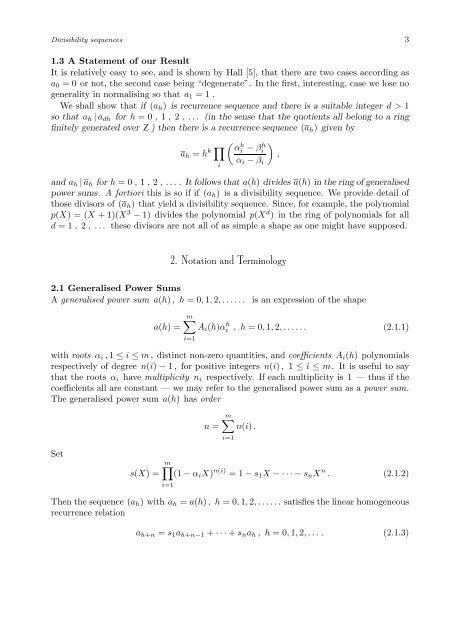A FULL CHARACTERISATION OF DIVISIBILITY SEQUENCES ...
A FULL CHARACTERISATION OF DIVISIBILITY SEQUENCES ...
A FULL CHARACTERISATION OF DIVISIBILITY SEQUENCES ...
Create successful ePaper yourself
Turn your PDF publications into a flip-book with our unique Google optimized e-Paper software.
Divisibility sequences 3<br />
1.3 A Statement of our Result<br />
It is relatively easy to see, and is shown by Hall [5], that there are two cases according as<br />
a0 = 0 or not, the second case being “degenerate”. In the first, interesting, case we lose no<br />
generality in normalising so that a1 =1.<br />
We shall show that if (ah) is recurrence sequence and there is a suitable integer d>1<br />
so that ah | adh for h =0, 1 , 2 , ... (in the sense that the quotients all belong to a ring<br />
finitely generated over Z ) then there is a recurrence sequence (ah) given by<br />
ah = h<br />
k <br />
i<br />
α h i − β h i<br />
αi − βi<br />
and ah | ah for h =0, 1 , 2 , .... It follows that a(h) divides a(h) in the ring of generalised<br />
power sums. A fortiori this is so if if (ah) is a divisibility sequence. We provide detail of<br />
those divisors of (ah) that yield a divisibility sequence. Since, for example, the polynomial<br />
p(X) =(X + 1)(X 3 − 1) divides the polynomial p(X d ) in the ring of polynomials for all<br />
d = 1 , 2 , . . . these divisors are not all of as simple a shape as one might have supposed.<br />
<br />
,<br />
2. Notation and Terminology<br />
2.1 Generalised Power Sums<br />
A generalised power sum a(h) , h =0, 1, 2, . . . . . . is an expression of the shape<br />
a(h) =<br />
m<br />
i=1<br />
Ai(h)α h i ,h=0, 1, 2, ...... (2.1.1)<br />
with roots αi , 1 ≤ i ≤ m, distinct non-zero quantities, and coefficients Ai(h) polynomials<br />
respectively of degree n(i) − 1 , for positive integers n(i) , 1 ≤ i ≤ m. It is useful to say<br />
that the roots αi have multiplicity ni respectively. If each multiplicity is 1 — thus if the<br />
coefficients all are constant — we may refer to the generalised power sum as a power sum.<br />
The generalised power sum a(h) has order<br />
Set<br />
s(X) =<br />
n =<br />
m<br />
n(i) .<br />
i=1<br />
m<br />
(1 − αiX) n(i) =1− s1X −···−snX n . (2.1.2)<br />
i=1<br />
Then the sequence (ah) with ah = a(h) ,h=0, 1, 2, ...... satisfies the linear homogeneous<br />
recurrence relation<br />
ah+n = s1ah+n−1 + ···+ snah ,h=0, 1, 2, ... . (2.1.3)
















